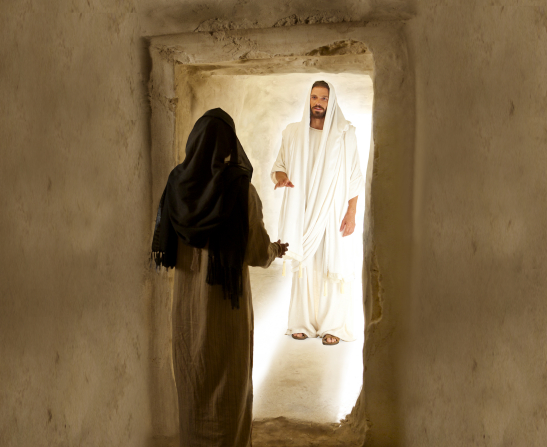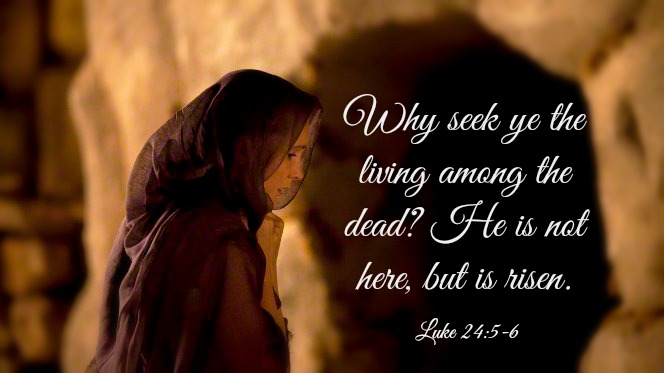As the weather warms and the snow begins to thaw, I start looking forward to the first buds of spring and the end of mud season. As the chill of winter often symbolizes death, the green buds of spring represent rebirth—a new beginning befitting the celebration of Easter, the Christian holiday celebrating the Resurrection of the Lord, Jesus Christ.
As a member of The Church of Jesus Christ of Latter-day Saints, I have always loved the celebration of Easter. I had friends who observed Lent, Ash Wednesday and Holy Week as part of their Easter traditions, but our family and religion do not. For us, the focus is on the Savior, Jesus Christ, and His Resurrection. President Ezra Taft Benson said,
The greatest events of history are those that affect the greatest number of people for the longest periods. By this standard, no event could be more important to individuals or nations than the resurrection of the Master.
The literal resurrection of every soul who has lived and died on earth is a certainty…. Nothing is more absolutely universal than the resurrection.
Local congregations conduct Sunday Easter services that often include Easter hymns and cantatas as well as speakers. The chapels are often decorated with white lilies and other symbols of life. The emblems of the sacrament are also passed to the congregation, as they are at Sunday worship services.
This is not to say that the Easter bunny hops past Mormon households. The Church of Jesus Christ does not discourage the use of the Easter bunny, colored eggs, baskets, etc. in family Easter traditions. The Easter bunny always visited my house when I was growing up, and he still hops by and leaves goodies for my kids. But there is no religious significance in this tradition, it’s just something fun for the kids.
For me, all of the bright colors of Easter, the eggs and the grass remind me of life. The life of the Savior. The purpose of Easter. President Thomas S. Monson said,
No words in Christendom mean more to me than those spoken by the angel to the weeping Mary Magdalene and the other Mary when, on the first day of the week, they approached the tomb to care for the body of their Lord. Spoke the angel: “Why seek ye the living among the dead? He is not here, but is risen.”
Why are these words so significant? President Monson explained,
Our Savior lived again. The most glorious, comforting, and reassuring of all events of human history had taken place—the victory over death. The pain and agony of Gethsemane and Calvary had been wiped away. The salvation of mankind had been secured. The Fall of Adam had been reclaimed.
While Mormons focus on the Resurrection of the Living Christ at Easter time, we do not forget His life, Atonement and Crucifixion. All are vital aspects to understanding the most powerful event in the history of the world.
The Mission and Ministry of the Savior
Jesus Christ came into the world to pave the way for all men and women to return to the presence of our Father in Heaven. To understand the mission and ministry of Jesus Christ, we must understand who He is. Elder Richard G. Scott taught,
Jesus Christ possessed merits that no other child of Heavenly Father could possibly have. He was a God, Jehovah, before His birth in Bethlehem. His Father not only gave Him His spirit body, but Jesus was His Only Begotten Son in the flesh. Our Master lived a perfect, sinless life and therefore was free from the demands of justice. He was and is perfect in every attribute, including love, compassion, patience, obedience, forgiveness, and humility.
Our Heavenly Father sent us to earth to be tested to see if we would obey His commandments in all things. He sent His Son, Jesus Christ, to teach us how to do this. Through His perfect, sinless life, Jesus Christ set the example for us to follow. This was part of His mortal ministry. President Russell M. Nelson said,
The Lord’s second far-reaching objective in mortality was to serve as an example for us. His exemplary life constituted His mortal ministry. It included His teachings, parables, and sermons. It encompassed His miracles, loving-kindness, and long-suffering toward the children of men (see 1 Nephi 19:9). It embraced His compassionate use of priesthood authority. It included His righteous indignation when He condemned sin (see Romans 8:3) and when He overthrew the tables of the money changers (see Matthew 21:12). It also included His heartaches. He was mocked, scourged, and disowned by His own people (see Mosiah 15:5)—even betrayed by one disciple and denied by another (see John 18:2–3, 25–27).
Wonderful as His ministerial acts were, they were not and are still not unique to Him. There is no limit to the number of people who may follow the example of Jesus. Similar acts have been done by His prophets and apostles and others among His authorized servants.
The mission of Jesus Christ, however, was His own. President Nelson said,
His mission was the Atonement. That mission was uniquely His. Born of a mortal mother and an immortal Father, He was the only one who could voluntarily lay down His life and take it up again (see John 10:14–18). The glorious consequences of His Atonement were infinite and eternal. He took the sting out of death and made temporary the grief of the grave (see 1 Corinthians 15:54–55). His responsibility for the Atonement was known even before the Creation and the Fall. Not only was it to provide for the resurrection and immortality of all humankind, but it was also to enable us to be forgiven of our sins—upon conditions established by Him. Thus His Atonement opened the way by which we could be united with Him and with our families eternally. This prospect we esteem as eternal life—the greatest gift of God to man (see Doctrine & Covenants 14:7).
The mission of the Savior was to perform the Atonement—which began in the Garden of Gethsemane and continued through His Crucifixion and death. The purpose of this magnificent Atonement was to remove the obstacles that would prevent us from returning to the presence of God.
The Atonement of Jesus Christ
The events that took place in the Garden of Gethsemane are sometimes difficult to comprehend. Here, Jesus Christ took upon Himself the pains and sins of the world. Elder M. Russell Ballard said,
There is no greater expression of love than the heroic Atonement performed by the Son of God. … As a result of Adam’s transgression, mortals were separated from God (see Romans 6:23) and would be forever unless a way was found to break the bands of death. This would not be easy, for it required the vicarious sacrifice of one who was sinless and who could therefore take upon Himself the sins of all mankind.
Thankfully, Jesus Christ courageously fulfilled this sacrifice in ancient Jerusalem. There in the quiet isolation of the Garden of Gethsemane, He knelt among the gnarled olive trees, and in some incredible way that none of us can fully comprehend, the Savior took upon Himself the sins of the world. Even though His life was pure and free of sin, He paid the ultimate penalty for sin—yours, mine, and everyone who has ever lived. His mental, emotional, and spiritual anguish were so great they caused Him to bleed from every pore (see Luke 22:44; Doctrine & Covenants 19:18). And yet Jesus suffered willingly so that we might all have the opportunity to be washed clean—through having faith in Him, repenting of our sins, being baptized by proper priesthood authority, receiving the purifying gift of the Holy Ghost by confirmation, and accepting all other essential ordinances. Without the Atonement of the Lord, none of these blessings would be available to us, and we could not become worthy and prepared to return to dwell in the presence of God.
The sacrifice of Jesus Christ continued through the events that led to His Crucifixion on the cross at Calvary. Elder Carlos H. Amado said,
Once His agony in Gethsemane was concluded, He voluntarily gave Himself up to His detractors. Betrayed by one of His own, He was hurriedly condemned, in a manner both unjust and illegal, in a trial both manipulated and incomplete. That same night He was accused of the crime of blasphemy and condemned to death. In their hatred and thirst for vengeance—because He testified to them that He was the Son of God—His enemies plotted for Pilate to condemn Him. To that end, they changed the accusation of blasphemy to sedition so that His death would be by crucifixion.
His condemnation among the Romans was even more cruel: their mockings and scorn regarding His spiritual kingdom, the humiliating coronation with a crown of thorns, His painful scourging, and the prolonged agony of His public Crucifixion were all a clear warning for every person who might dare to declare himself or herself His disciple.
And, indeed, many of His disciples did distance themselves from Him in the final hours of His life. Not only did Judas Iscariot betray Jesus Christ to those who sought His life, but Peter also denied thrice his association with the Master. The Savior’s journey to Atonement was a lonely road. Elder Jeffrey R. Holland explained,
Now I speak very carefully, even reverently, of what may have been the most difficult moment in all of this solitary journey to Atonement. I speak of those final moments for which Jesus must have been prepared intellectually and physically but which He may not have fully anticipated emotionally and spiritually—that concluding descent into the paralyzing despair of divine withdrawal when He cries in ultimate loneliness, “My God, my God, why hast thou forsaken me?” …
It is my personal belief that in all of Christ’s mortal ministry the Father may never have been closer to His Son than in these agonizing final moments of suffering. Nevertheless, that the supreme sacrifice of His Son might be as complete as it was voluntary and solitary, the Father briefly withdrew from Jesus the comfort of His Spirit, the support of His personal presence. It was required, indeed it was central to the significance of the Atonement, that this perfect Son who had never spoken ill nor done wrong nor touched an unclean thing had to know how the rest of humankind—us, all of us—would feel when we did commit such sins. For His Atonement to be infinite and eternal, He had to feel what it was like to die not only physically but spiritually, to sense what it was like to have the divine Spirit withdraw, leaving one feeling totally, abjectly, hopelessly alone.
But Jesus Christ did not shrink from His painful, lonely task. And each step of the way, His Divinity showed through His actions. Elder Amado said,
At each moment of His suffering, the Redeemer of the world showed exceptional self-control. He always thought of blessing others; with kindness and tenderness, He pleaded for John to take care of His mother, Mary. He asked His Father in Heaven to forgive the executioners who crucified Him. With His work on earth fulfilled, He commended His spirit to God and breathed His last breath.
Jesus Christ had performed the work that He came here to do: He atoned for the sins and suffering of mankind. The perfect, sinless Son of God suffered the pains, anguish and wrongs of every person who has ever lived or will ever live on the earth. And He did so willingly, lovingly and perfectly. But this is not the end of the story. It is just the beginning of a new one.
The Resurrection
After the death of Jesus Christ, His body was placed in a tomb and a stone placed in front of the door. The next day was the Sabbath, and the women did not have time to complete the final preparations of His body for burial. It must have been a time of great sorrow for the faithful followers of Jesus Christ. Elder D. Todd Christofferson taught,
A crushing sense of defeat and despair enveloped His disciples as Jesus suffered and died on the cross and His body was placed lifeless in the tomb. Despite what the Savior had repeatedly said of His death and subsequent rising again, they had not understood.
Why had His disciples not understood? President James E. Faust explained,
The idea that one who has died can live again was so unprecedented, so foreign to all human experience, that even the Apostles, who had been told it would happen, could hardly believe it.
Early on the morning of the third day, Mary Magdalene and a few other faithful women went to the tomb to finish. There, to their horror, the stone had been rolled away and the tomb of their beloved Lord and Master was empty. Inside the open sepulcher, they encountered two angels, who asked them, “Why seek ye the living among the dead? He is not here, but is risen” (Luke 24:5-6). But did they truly understand the magnitude of the angels’ words? President Faust continued,
As Mary stood without the sepulchre weeping, she was addressed by an apparent stranger with two ever-so-tender, compassionate questions: “Woman, why weepest thou? whom seekest thou?” In her grief and blinded by tear-filled eyes, she pleaded with the stranger, whom she supposed to be the gardener, “Sir, if thou have borne him hence, tell me where thou hast laid him, and I will take him away.
“Jesus saith unto her, Mary. She turned herself.” (John 20:15–16.)
One, only one, person could speak her name that way. With that single word all doubt, confusion, and uncertainty was swept away. Mary, in that instant, came to the grand, sublime realization that he for whom she mourned, even Jesus that was crucified, had risen from the dead, just as the angels early that very morning had testified….
Mary was the first but not the only person to witness the Resurrected Lord. Elder Christofferson said,
Later that same day He appeared to Peter in or near Jerusalem; to two disciples on the road to Emmaus; and in the evening to 10 of the Apostles and others, appearing suddenly in their midst, saying, “Behold my hands and my feet, that it is I myself: handle me, and see; for a spirit hath not flesh and bones, as ye see me have.” Then to further convince them “while they yet believed not for joy, and wondered,” He ate broiled fish and honeycomb before them.
The glorious day of the Resurrection had come—the reason for our Easter celebration. Jesus Christ was the first person to die and then be resurrected. But He is not the only one. His Resurrection broke the bands of death for all. Mormons believe in a universal and literal resurrection. It is the universal Easter gift that we celebrate. Elder Ballard said,
Easter is a time when the Christian world focuses on and rejoices in the Resurrection of our Lord and Savior Jesus Christ. That one moment in time changed everything forever. The Savior broke down every barrier that stood in the way of our return to a loving Heavenly Father.


